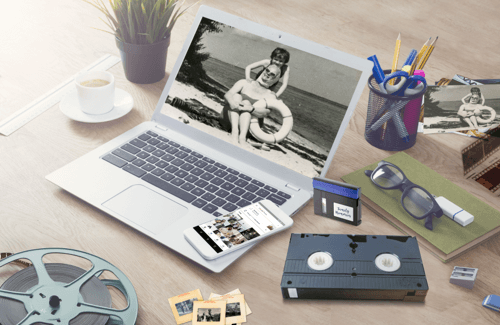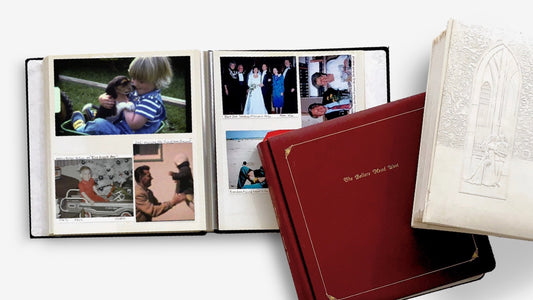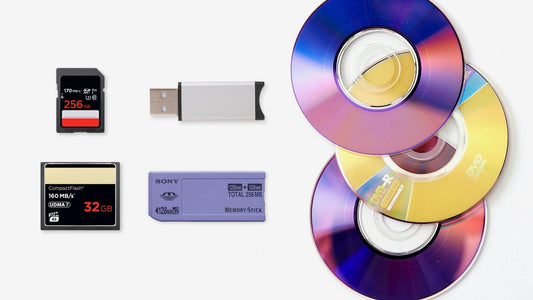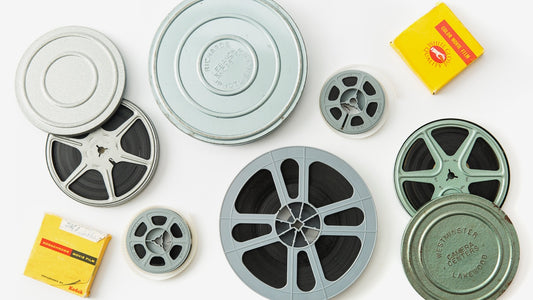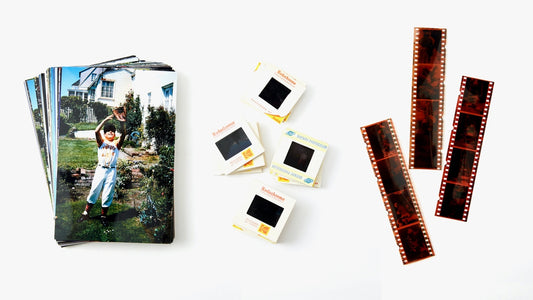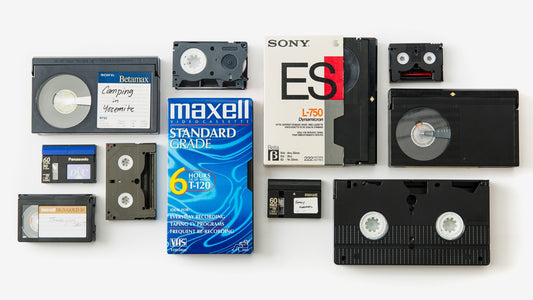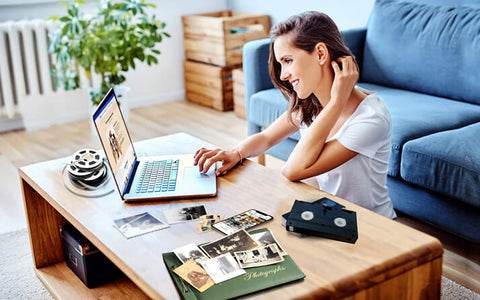There's something uniquely captivating about holding a photo slide up to the light, seeing a memory illuminated in vibrant color. These slides hold a special place in many family histories, capturing moments with a richness and depth that modern photos can miss. This guide is your complete resource for preserving and celebrating your entire collection. We’ll show you how to protect them from the effects of time and walk you through the process to digitize photo slides, ensuring these precious memories can be shared and enjoyed for years to come.
Key Takeaways
- Photo slides provide vibrant, lasting memories: Their unique format captures rich colors and details, offering a tangible connection to the past. Digitizing your slides ensures these memories stay vivid and accessible for generations to come.
- Digitizing slides unlocks new ways to share and enjoy: Create digital albums, personalized gifts, and artistic projects with your digitized images. Services like YesVideo make the process simple, preserving your memories with high-quality digital conversions.
- Slides are a valuable piece of family history: They represent a unique era of visual storytelling and shared experiences. Digitizing your slides, whether through DIY methods or professional services, protects these irreplaceable memories and allows you to share your family's story.
What Are Photo Slides?
Breaking Down the Basics
Photo slides, also known as transparencies, offer a unique way to capture and display images. Unlike traditional photographic prints, slides are developed directly onto a transparent film—creating a positive image viewable by holding it up to a light or projecting it onto a larger screen. This "reversal film" process distinguishes slides from negatives, which require further processing to produce a viewable image. Slides were especially popular in the mid-20th century and are currently enjoying a resurgence, thanks to their distinct physical and nostalgic qualities. They offer a tangible connection to the past and a viewing experience unlike digital images. For many, the ritual of setting up a projector and sharing memories with loved ones adds to their enduring appeal. You can learn more about reversal film on Wikipedia.
The Anatomy of a Photo Slide
At its most basic, a photo slide consists of the image itself on a transparent film base. This film is then mounted within a frame, typically made of cardboard or plastic, to protect it and allow for easy handling and projection. These framed slides are designed to be used with slide projectors, which illuminate the slide from behind and project the magnified image onto a screen or wall. The earliest photographic slides, called Hyalotypes, date back to 1850. These early slides paved the way for projected photographic images, replacing the painted images used in magic lanterns. The development of different film formats and mounting standards over the years has led to a variety of slide sizes and types, each with its own characteristics. Understanding these components helps in preserving and digitizing your slides, ensuring your memories remain vivid for generations. YesVideo offers professional digitization services to help preserve your photo slides. You can explore the history of photo slides in more detail on Legacybox.
A Look Back at the History of Photo Slides
The Dawn of Slides: Magic Lanterns & Kodachrome
The story of photo slides starts long before the familiar click and whir of the carousel projector. We can trace their origins back to the 17th century and the magic lantern. These early projectors cast painted images on glass slides, creating captivating displays. The magic lantern's use of projected images set the stage for what would become a cherished way to share memories and stories. The first actual photographic slide, the Hyalotype, appeared in 1850, developed by the Langenheim brothers. This process replaced painted images with real photographs, a major advancement. The Hyalotype set the stage for color photography, and in 1935, Kodachrome film was introduced, changing how we capture and view images. This commercially successful color process became a mainstay of slide photography for decades.
The Golden Age of the Carousel Projector
The mid-20th century brought a key innovation: the carousel slide projector. Patented in 1965, this device quickly became a common sight in homes. The carousel projector's circular tray made changing slides easy, creating seamless presentations. Families gathered around lit-up screens, reliving vacations and special occasions. The carousel projector changed how we shared memories, making it simpler and more engaging. This development also proved invaluable for educators, providing a dynamic way to present information in the classroom.
How Slides Shaped Family Memories
Before movies and television became widespread, photo slides and projectors held a significant place in entertainment and culture. Getting together to watch slideshows projected onto walls became a treasured communal activity, creating a sense of shared experience. Slides weren't just for fun; they played a vital role in preserving family history, teaching students, giving business presentations, and displaying artwork in exhibitions. Their durability, a key advantage over traditional prints, ensured these memories would last. Photo slides offered a unique blend of personal and shared experiences, shaping how we documented and celebrated life's important moments.
How Do Photo Slides Actually Work?
How a Projector Brings Slides to Life
Before streaming and digital photos, slideshows were a major form of entertainment. Families and friends would gather to watch images projected onto a wall or screen. This simple process involved a light source, a lens, and the slide itself. Light passed through the transparent slide, the lens magnified and focused the image, and voilà—instant home entertainment. The development of the carousel slide projector streamlined viewing, allowing for smooth transitions between images.
From Film to Frame: Creating the Image
Photo slides use a special type of reversal film to create a positive image directly on the film. This positive image, also known as a transparency or slide, is what gets projected. Unlike negatives, which require additional processing, slides offer a direct, vibrant representation of the captured scene. You can view these images by holding them up to a light source or using a slide viewer. Early color slide processes involved complex methods like dyeing materials on glass plates. Kodachrome, introduced in 1935, was a major advancement, offering a more practical and commercially successful color process. This made color slides more accessible, contributing to their widespread popularity.
The Enduring Appeal of Photo Slides
Photo slides offer distinct advantages, especially when compared to traditional prints. Let's explore what makes them so special.
Unmatched Color and Image Quality
Remember those vibrant family vacations or stunning sunsets captured on slides? The film used for slides, called reversal film, creates a positive image directly on the transparent sheet. This differs from print photos, which develop from negatives. This direct positive process generally produces richer, more vibrant colors, making slides ideal for showcasing your most treasured photographs. The difference is noticeable, especially with nature photography or images with bold, saturated colors. For a deeper dive into how slide film works, check out this Wikipedia article.
Built to Last: The Durability of Film Slides
Slides were a popular choice for preserving family history for a good reason: their durability. Unlike prints that can fade, tear, or become damaged over time, slides are surprisingly robust. This resilience allows them to withstand the test of time, making them a reliable medium for safeguarding those precious memories. This guide to photo slides offers a great overview of their lasting power. Proper storage is key, of course, which we'll discuss later.
More Than Memories: Slides for Learning
Before the days of easily accessible movies and television, photo slides and slide projectors were a major source of entertainment. Families and friends would gather for slideshow nights, projecting images onto walls and sharing stories. This communal viewing experience made slides an effective tool for presentations, whether sharing travel adventures or for educational purposes in classrooms. This article on the history of photo slides explores this fascinating history. Even today, the focused, large-format presentation a slide offers can be impactful. And, with digitization, sharing those memories becomes even easier.
How to Preserve Your Photo Slides
Looking to safeguard those irreplaceable memories captured on photo slides? Proper preservation is key to ensuring your slides stand the test of time. Here’s how to protect your collection:
The Right Way to Store Your Slides
Think of your slides as tiny time capsules. To keep them safe, store them in a cool, dry, and stable environment. Avoid attics, basements, and garages, as these areas are prone to temperature fluctuations and humidity, which can damage your slides. Instead, opt for a climate-controlled area within your home. Archival-quality storage boxes are ideal for protecting slides from dust, light, and pests.
Tips for Safely Handling and Cleaning
When handling slides, hold them by the edges to avoid fingerprints and scratches. Before digitizing, gently remove dust and debris. A soft, lint-free cloth, like a microfiber cloth, works well. For more stubborn dirt, consider using a specialized slide cleaning solution and follow the product instructions carefully. Remember, gentle is the name of the game—avoid harsh rubbing.
Get Organized: How to Catalog Your Collection
A well-organized collection is a joy to revisit. Arrange your slides chronologically or by subject matter. Label each slide or storage container with key details like dates, locations, and the people pictured. This will make it much easier to locate specific slides later. If you're considering digitization, a professional service like YesVideo can handle the organization and cataloging for you, creating a streamlined digital archive of your precious memories.
How to Digitize Your Photo Slides
Converting your physical slides to digital files opens a world of possibilities, from easy sharing and editing to enhanced preservation. Let's explore some options for making the transition.
Digitizing Slides at Home: A DIY Guide
Several do-it-yourself methods exist for digitizing slides, each with its own pros and cons. You can use a dedicated slide scanner, which delivers the highest quality images but represents a larger investment. Slide scanners capture the intricate details and vibrant colors of your originals, making them ideal for archiving precious memories. If you're working with a smaller collection or have a tighter budget, consider using a smartphone app. Many apps offer decent image quality and are a convenient option for quick digitization. Another route is using a photo processing store like Costco or Walgreens. This offers a middle ground in terms of cost and convenience, though the quality might not match a dedicated scanner.
Method 1: Using a Slide Scanner
For those who prioritize image quality, a dedicated slide scanner is often the best choice. Many experts agree this is one of the fastest ways to get high-quality digital copies of your slides. Flatbed scanners like the Epson V850 can handle about 12 slides at once, offering a good balance of speed and quality for smaller collections. If you have a mountain of slides to get through, more advanced machines like the Nikon CoolScan 5000 or the Pacific Image PowerSlide can automate the process, scanning up to 50 slides in a single batch. While these scanners represent a financial investment, they are designed specifically for this task, capturing the rich colors and fine details of your original transparencies with impressive accuracy.
Method 2: Using a Digital Camera Setup
If you already own a digital camera, you can create a setup to digitize your slides with surprising speed. This method involves using a macro lens and a light source to essentially re-photograph each slide. You can find "slide duplicator" attachments that screw onto your lens or build a "copy stand" to hold the camera steady above an illuminated slide. The biggest advantage here is speed; it’s as quick as taking a picture, so you don't have to wait for a machine to scan. One person reported digitizing over 1,000 slides in just a few evenings while watching TV. This approach is incredibly efficient, but it may require some trial and error to get the lighting and focus just right for a perfect copy.
Key Considerations for Any DIY Project
No matter which DIY method you choose, it’s important to be realistic about the commitment. Digitizing hundreds or thousands of slides takes a lot of time and patience. For the best results, you’ll want to aim for a resolution of at least 2000-3000 dots per inch (dpi) to ensure the digital files are high quality. Also, remember that the work doesn’t end with the scan. You will likely need to do some photo editing afterward to correct colors, crop images, and remove dust specks. If the time and technical effort sound overwhelming, a professional photo transfer service can be a great alternative, handling the entire process to give you high-quality digital memories without the hassle.
When to Hire a Professional Service
For a hassle-free experience and top-notch results, consider using a professional slide scanning service like YesVideo. We handle the entire process, from carefully handling your slides to delivering high-resolution digital files. Our photo digitization service, which includes slides, starts at $32.99 for the first 50 items and $0.56 for each additional item, making it an affordable way to preserve your memories. With professional services, you can rest assured that your slides are in expert hands.
Comparing Professional Digitization Services
When you decide to hand over your precious memories, you want to be sure you're choosing the right partner. Professional digitization services vary in their pricing, quality, and features, so it’s worth doing a little homework to find the best fit for your collection. Think about what matters most to you—is it the highest possible resolution, the most straightforward pricing, or the peace of mind that comes with a trusted process? Answering these questions will help you sort through the options and select a service that will treat your slides with the care they deserve.
Understanding Pricing Structures
Pricing for slide digitization can look different from one company to the next. Some services, like Legacybox and Southtree, use a box-based model where you purchase a kit, fill it with a set number of items, and send it in. This can be simple, but it's important to check the fine print for what counts as an "item" and what happens if you have more or fewer slides than the box allows. Other companies charge per slide, which can be more transparent. At YesVideo, we offer clear, upfront pricing so you know exactly what to expect. This approach helps you avoid surprises and makes it easy to calculate the cost for your specific collection, no matter the size.
Comparing Scan Quality and Resolution
The quality of the final digital image is probably your top priority. A key metric to look for is DPI, or dots per inch, which measures scan resolution—higher DPI generally means a sharper, more detailed image. Some services, like Nostalgic Media, scan at 3,200 DPI, while others go even higher. But resolution isn't the only factor. Look for services that offer manual inspection and color correction, as companies like Southtree do. This human touch ensures that the colors in your digital photos look as true-to-life as they did on film. At YesVideo, every order is processed by hand by our team of trained technicians, ensuring your memories are not only digitized at high quality but also handled with personal care.
Service Features and Policies to Consider
Beyond price and quality, consider the overall experience. A crucial question is: how will the company handle your originals? You'll want a service that guarantees the safe return of your slides. Look for features like order tracking and in-house processing, which provide extra security. It's also good to check what digital delivery options are available, whether it's a USB drive, a digital download, or DVDs. Companies like YesVideo have built a reputation on trust for over 20 years, processing every order in the USA, so you can feel confident that your one-of-a-kind memories are in safe hands from start to finish.
Understanding Services from Major Retailers
You might have noticed that major retailers like Costco and Walmart also offer media digitization. These services can seem convenient since you can drop off your slides at a familiar location. For example, Costco's service is priced per slide with a minimum order fee. While the convenience is appealing, it's important to understand that these retailers typically don't handle the digitization themselves. Instead, they partner with a third-party company to process the orders. This can sometimes mean less control over the quality and a more complicated customer service process if you have questions or concerns. When you're dealing with something as irreplaceable as family memories, working directly with a specialized photo transfer service often provides greater peace of mind.
Common Digitization Problems & Solutions
Whether you choose DIY or professional digitization, a few common challenges can arise. Dust and dirt can significantly impact image quality, so carefully cleaning your slides beforehand is crucial. Record Nations offers helpful tips on cleaning slides. Another challenge is the time commitment involved, especially for large collections. Digitizing slides can be a time-consuming process, so factor that into your plans. If you're short on time or patience, a professional service might be the best option.
Your Slides Are Digital. Now What?
Once your slides are digitized, a whole world of creative opportunities opens up. It’s not just about preservation—it’s about bringing those memories back to life in fresh, new ways.
Create Modern Digital Albums and Slideshows
Digitizing your photo slides makes them easily shareable. Create digital photo albums and slideshows to enjoy with family and friends. Set your slideshow to music, add narration, or create themed presentations around holidays, vacations, or family milestones. Sharing these digital memories strengthens connections and helps keep family history alive. Services like YesVideo can help you preserve these precious memories.
Turn Your Memories into Unique Decor and Gifts
Those digitized images can become unique home décor and personalized gifts. Consider printing your favorite slides onto canvas, creating custom mugs or blankets, or designing one-of-a-kind phone cases. You can also incorporate the images into greeting cards, calendars, or even fabric prints for throw pillows or quilts. These personalized items make thoughtful gifts and add a personal touch to your home. Even after digitization, don't forget the original slides! Repurpose them in craft projects or create decorative displays in shadow boxes or glass jars. For more ideas and inspiration, check out online resources like Capture.
Get Creative with Your Digital Archive
Think outside the box and explore the artistic potential of your digitized slides. Use photo editing software to create collages, add artistic filters, or combine images with text and other design elements. You can also use your digitized slides as inspiration for paintings, drawings, or other mixed-media artwork. These artistic projects celebrate personal memories and milestones in a unique and expressive way. Consider using a series of related slides to tell a visual story, or focus on a single striking image to create a statement piece. Explore the rich history of photo slides and their artistic uses at Legacybox.
What's Next for Photo Slides?
How Modern Tech Compares to Classic Slides
Digital photography has largely replaced slides because of its convenience, affordability, and ease of sharing and editing. We can instantly see the results, easily share photos online, and quickly edit them with software. Still, countless families have boxes of slides containing precious memories. Preserving these slides by digitizing them is crucial to protect them from damage and loss. You can digitize slides yourself using a slide scanner, or use a professional photo scanning service like YesVideo. Converting your photo slides to digital images preserves those memories and makes them easily shareable.
Why Collectors and Artists Still Use Slides
While everyday use has declined, photo slides still hold a special place. They represent a significant step in the evolution of visual entertainment and communal experiences, acting as a precursor to modern forms of media. The nostalgic appeal of photo slides also contributes to their continued relevance. Remember family gatherings huddled around a projector? That shared experience is unique to slides. They were also widely used for preserving family history, education, business presentations, and exhibitions. Their durability was a key advantage, making them ideal for archiving important images. Today, collectors appreciate slides for their historical significance and the tangible connection they offer to the past. While digital images dominate, photo slides retain a certain charm, particularly for those interested in history and photography.
Why Your Old Slides Are Worth Saving
Connecting With Your Family's History
Photo slides offer a unique glimpse into the past, often capturing moments in vivid detail that other formats couldn't. For many families, slides were the way to document everything from birthdays and holidays to graduations and family vacations. Unlike faded prints tucked away in albums, slides projected onto a screen brought these memories to life, larger than life. This made them a powerful tool for preserving family history, passing down stories, and connecting generations. Converting photo slides to digital ensures these precious memories are safeguarded against damage, loss, or deterioration, allowing future generations to experience these moments just as vividly as the original photographer. Protecting these visual records is an investment in your family's legacy. Slides were often more durable than traditional prints, making them a reliable medium for preserving important moments.
Passing Down Stories, One Slide at a Time
More than just static images, photo slides tell stories. Gathering around a projector and screen created a shared experience, a communal way to relive special occasions and connect with loved ones. The history of photo slides reveals their significance in visual entertainment and shared experiences, acting as a precursor to how we consume media today. The nostalgic appeal of slides remains strong, even in our digital world. Digitizing your slides makes it easier than ever to share these stories with family and friends, whether through online albums, slideshows, or even incorporating them into creative projects. YesVideo's photo transfer services can help you preserve and share these precious memories. By digitizing and sharing, you keep these stories alive and ensure they continue to connect generations to come.
Related Articles
- Additional Slides – YesVideo
- YesVideo's Film Transfer - Transfer Old Film Reels to Digital
- YesVideo's Photo Digitization - Digitize Old Slides, & More
- Slide Transfer – YesVideo
- Gift Ideas – YesVideo
Frequently Asked Questions
What are the main differences between photo slides and printed photos?
Photo slides use a positive image on a transparent film, viewable by shining light through them or projecting them. Prints, on the other hand, create the image on paper, making them immediately viewable without any special equipment. Slides often have more vibrant colors and better longevity than prints, but they require a projector or viewer to be properly appreciated.
Why were photo slides so popular in the past?
Before digital cameras and readily available movies and television, photo slides were a primary way to share visual stories and memories. Projecting slides onto a large screen created a communal viewing experience, perfect for family gatherings or educational presentations. Their vibrant colors and durability also made them a favored choice for preserving important moments.
What's the best way to digitize my old photo slides?
You have a few options. Dedicated slide scanners offer the highest quality but can be pricey. Smartphone apps are a convenient and budget-friendly choice for smaller collections. Photo processing stores offer a middle ground. For a hassle-free experience and professional results, consider a service like YesVideo, which handles the entire process for you.
How can I creatively use my digitized photo slides?
Digital slides open up a world of possibilities. Create dynamic digital albums and slideshows set to music. Design personalized gifts like mugs, blankets, or calendars featuring your favorite images. Incorporate them into artistic projects, creating collages or using them as inspiration for other artwork.
Are photo slides still relevant today?
While digital photography has largely replaced slides for everyday use, they still hold value. Many families have collections of slides filled with precious memories that are worth preserving. Slides also have a nostalgic appeal and are appreciated by collectors for their historical significance in the evolution of visual media. Digitizing them ensures these memories remain accessible and vibrant for future generations.




